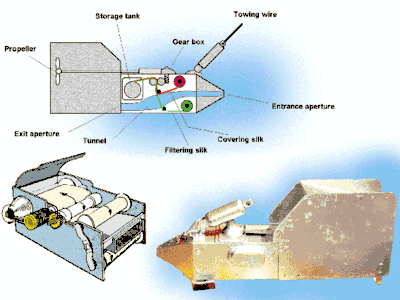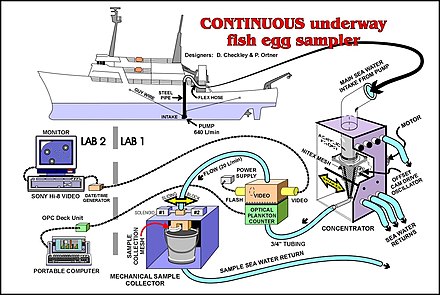Continuous Plankton Recorder
The Continuous Plankton Recorder (CPR) Survey is one of the longest running marine biological monitoring programmes in the world. Started in 1931 by Sir Alister Hardy and Sir Cyril Lucas,[1] the Survey has provided marine scientists with their only measure of plankton communities on a pan-oceanic scale. Today the CPR Survey is operated by the Marine Biological Association(MBA), located in Plymouth, UK. Uniquely, the CPR Survey’s methods of sampling and plankton analysis remain unchanged since 1948, providing a spatio-temporally comprehensive > 70 year record of marine plankton dynamics.
Sampling and analysis

The CPR is a plankton sampling instrument designed to be towed from merchant ships, or ships of opportunity, on their normal sailings. As of December 31, 2007, CPRs have been towed a total of 5,460,042 nmi (10,111,998 km) by 278 ships since the survey’s inception. Recorders have been towed in all oceans of the world, the Mediterranean, Baltic and North Seas and in freshwater lakes. However, MBA CPR sampling primarily focuses on the northwest European shelf and the Northeast and Northwest Atlantic, with these regions undergoing monthly sampling; regular sampling is also now carried out in the North Pacific. Additionally, sister CPR surveys, not conducted by the MBA but using similar methodology, are operated from the United States, Australia, India, Cyprus, Brazil, South Africa, France and Japan, as part of the Global Alliance of Continuous Plankton Recorder Surveys (www.globalcpr.org)
The CPR is towed at a depth of approximately 10 metres. Water passes through the CPR and plankton are filtered onto a slow-moving band of silk (270 micrometre mesh size) and covered by a second silk. The silks and plankton are then spooled into a storage tank containing formalin. On return to the laboratory, the silk is removed from the mechanism and divided into samples representing 10 nautical miles (19 km) of tow.
CPR samples are analyzed in two ways. Firstly, the Phytoplankton Colour Index (PCI) is determined for each sample. The colour of the silk is evaluated against a standard colour chart and given a 'green-ness' value based on the visual discoloration of the CPR silk produced by green chlorophyll pigments; the PCI is a semi-quantitative estimate of phytoplankton biomass. In this way the PCI takes into account the chloroplasts of broken cells and small phytoplankton which cannot be counted during the microscopic analysis stage. After determination of the PCI, microscopic analysis is undertaken for each sample, and individual phytoplankton and zooplankton taxa are identified and counted. Nearly 500 phyto- and zooplankton taxa have been identified on CPR samples since 1948.[2] [3]
Ecological research

Due to its long time-series, comprehensive spatial coverage and methodological consistency, the Continuous Plankton Recorder Survey is a unique ecological dataset which has provided invaluable insights into numerous aspects of plankton dynamics and ecology. Key areas of research include:
- Climate change
- Biodiversity and biogeography
- Eutrophication
- Harmful Algal Blooms (HABs)
- Fisheries investigations
- Plankton ecology
- Taxonomy
- Regime shifts
- Non-indigenous species
Their research results show that warmer water species of plankton are moving northwards towards the colder North Atlantic at a rate of about 23 km (14 mi) per year and that some plankton species have moved 1,000 km (620 mi) north over the course of 50 years due to regional climate warming. But they are not replacing the cold water species in similar abundance. The open oceans are not yet subject to eutrophication or changes due to acidification though the number of microplastics collected on CPR samples is increasing. It has detected a new species in the North Atlantic which may be the first evidence of Trans-Arctic species migration in modern times.[4]
References
- https://www.telegraph.co.uk/news/obituaries/1386001/Sir-Cyril-Lucas.html
- Reid, P.C.; Colebrook, J.M.; Matthews, J.B.L.; Aiken, J.; et al. (2003). "The Continuous Plankton Recorder: concepts and history, from plankton indicator to undulating recorders". Progress in Oceanography. 58 (2–4): 117–175. doi:10.1016/j.pocean.2003.08.002.
- Warner, A.J., and Hays, G.C.,; Hays, G (1994). "Sampling by the Continuous Plankton Recorder survey". Progress in Oceanography. 34 (2–3): 237–256. doi:10.1016/0079-6611(94)90011-6.CS1 maint: extra punctuation (link)
- Edwards, M.; et al. (2016). "Global Marine Ecological Status Report" (11). Sir Alister Hardy Foundation for Ocean Science. ISSN 1744-0750. Cite journal requires
|journal=(help)
